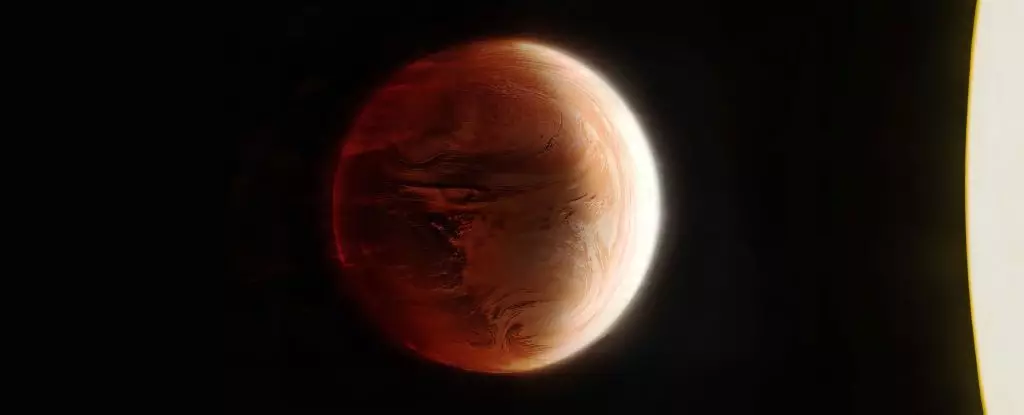Located approximately 880 light-years from Earth, Tylos (WASP-121b) presents one of the most extraordinary demonstrations of planetary atmospheres we have yet observed. This exoplanet orbits perilously close to its sun, resulting in an environment rife with extremes. Its atmosphere, laden with clouds of vaporized metals, creates conditions so inhospitable that it rains precious stones—rubies and sapphires—onto its surface. Such extreme phenomena challenge conventional wisdom about atmospheric sciences, making Tylos a focal point for astrophysicists and planetary scientists alike.
Astrophysicist Julia Victoria Seidel from the European Southern Observatory articulates the exceptional nature of Tylos’ atmosphere, stating, “This planet’s atmosphere behaves in ways that challenge our understanding of how weather works – not just on Earth, but on all planets.” Her observation casts a new light on our previous assumptions, indicating our knowledge about atmospheric dynamics must evolve as we encounter these exotic worlds.
Tylos exemplifies what astronomers classify as a “hot Jupiter.” These planets bear similarities in mass and size to our giant planets but orbit much closer to their host stars. The result is a marked increase in surface temperature, often surpassing that of some stars. With a radius approximately 1.74 times that of Jupiter and a mass 1.16 times greater, Tylos orbits its F-type star, Dilmun, with a staggering rotation period of roughly 30 hours. Its equilibrium temperature peaks at around 2,360 Kelvin (over 2,087 degrees Celsius or 3,788 degrees Fahrenheit).
Yet, the implications of this extreme temperature are twofold: the immense heat perpetuates atmospheric loss, making Tylos a site of continuous evaporation. This dynamic raises critical questions about the molecular makeup and transformation of such distant atmospheres. The dissipating gases provide valuable insights into the elements that compose Tylos’ environment, making it a target for innovative observational strategies.
To probe deeper into Tylos’ complex atmosphere, researchers employed the European Southern Observatory’s Very Large Telescope (VLT), utilizing all four telescope units to compile an unprecedented view of this celestial body. Their findings revealed a staggering complexity of atmospheric behavior. Central to these revelations is a remarkable jet stream that traverses the planet’s equator, rotating material rapidly while inducing a separate flow that transfers hot gases toward the cooler sectors of the atmosphere.
Seidel describes the results as groundbreaking, explaining, “This kind of climate has never been seen before on any planet.” The winds measured during their observations offer a stark contrast to our familiarity with weather systems. For example, the recorded speed of the jet stream reached 27 kilometers per second (nearly 60 miles per hour), outperforming any atmospheric currents found in our own Solar System.
Tylos’ unique orbital positioning makes it tidally locked, meaning the same hemisphere perpetually faces its star, creating an extreme temperature gradient between the day and night sides. This stark contrast gives rise to extraordinarily powerful winds that achieve supersonic speeds. Researchers observed a substantial temperature differential of around 950 Kelvin from one side of the planet to the other, exacerbating the intensity of atmospheric movements.
The transit of materials—especially iron clouds—within Tylos’ atmosphere generates a super-rotational mechanism that accelerates atmospheric dynamics far beyond the planet’s rotational speed. Such phenomena pitch new ideas concerning atmospheric behavior, prompting scientists to reevaluate wind and weather patterns on planets both within and outside our Solar System.
The study of Tylos provides a crucial framework for future exoplanetary research. The sophisticated blending of observational tools allows scientists to dissect the chemical composition and weather dynamics of a world situated so far beyond our reach. Bibiana Prinoth, an astrophysicist at Lund University, summarizes the significance of these findings perfectly: “It’s truly mind-blowing that we’re able to study details like the chemical makeup and weather patterns of a planet at such a vast distance.”
As we continue to unveil the mysteries of exoplanets like Tylos, our understanding of planetary atmospheres, climate dynamics, and the potential for life elsewhere in the universe will undoubtedly evolve, posing one intriguing question: How many more surprises do the cosmos have in store for us?


Leave a Reply